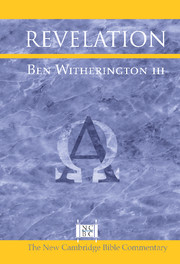Book contents
- Frontmatter
- Contents
- Preface
- A Word about Citations
- Map of Western Asia Minor and the Island of Patmos
- List of Roman Emperors
- List of Abbreviations
- I INTRODUCTION
- II SUGGESTED READING ON REVELATION
- III COMMENTARY
- IV APPENDIX: A MILLENNIAL PROBLEM
- Author Index
- Extra-Biblical Texts Index
- Scriptural Index
- Subject Index
IV - APPENDIX: A MILLENNIAL PROBLEM
Published online by Cambridge University Press: 05 February 2015
- Frontmatter
- Contents
- Preface
- A Word about Citations
- Map of Western Asia Minor and the Island of Patmos
- List of Roman Emperors
- List of Abbreviations
- I INTRODUCTION
- II SUGGESTED READING ON REVELATION
- III COMMENTARY
- IV APPENDIX: A MILLENNIAL PROBLEM
- Author Index
- Extra-Biblical Texts Index
- Scriptural Index
- Subject Index
Summary
Without question, one of the most problematic of passages not only in the book of Revelation but in the entire New Testament is Rev. 20.4–6. Elaborate eschatological schemas have been generated using this text as the linchpin of their arguments, whether one takes an amillennial, premillennial, or postmillennial view of John's argument. It therefore behooves us to give some more detailed consideration to the grammar, syntax, and meaning of these verses. Until the twentieth century, hardly any commentator denied that Rev. 20.4–6 referred to a historical period, whether past, present, or future, and even today most commentators believe that John was intending to be historically referential when he presented this material.
The two major millennial viewpoints within the Christian community are the amillennial (traditionally held by most Catholics, mainline Protestants, and conservative Reformed denominations) and the premillennial (traditionally held by most Evangelicals and today, in its dispensational form, overwhelmingly the most popular form of eschatology for conservative Protestants, charismatics, and messianic Jews). This issue has been brought to the fore again recently by the best-selling series of novels by Timothy LaHaye and others, entitled the Left Behind series, which to a large extent is based on a certain kind of dispensational interpretation of the book of Revelation. The amillennial view differs from that of the premillennial (whether historic premillennial or the dispensational form) in believing that the church age is the millennium and that there will be one general resurrection of the dead after Christ returns, followed by final judgment and the new heaven and the new earth.
In Rev. 20.1–3 there are two events that are important to what follows in Rev. 20.4–6: (1) the descent of the angel from heaven and (2) the binding of Satan and sealing him in the abyss for a thousand years “in order that he not deceive the nations any more.” One must ask where John envisions this activity taking place. We are told that the binding takes place “out of heaven,” for that is where the angel comes from to bind Satan. Earlier in Revelation it was said that Satan had been cast down upon the earth from the heavens (see Rev. 12.8–9). It is then logical to conclude that this binding happens not in heaven.
- Type
- Chapter
- Information
- Revelation , pp. 286 - 292Publisher: Cambridge University PressPrint publication year: 2003



